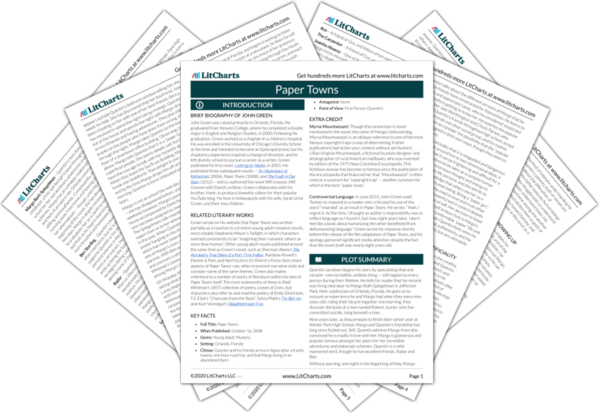The events of the novel cause Quentin to consider multiple different philosophies about the ways in which human beings build connections with one another, and about the nature of those connections. Reading Walt Whitman’s poem “Song of Myself” he becomes interested in Whitman’s idea that all human beings are tied together, like blades of grass that share the same root system, and have a limitless ability to understand and empathize with one another. He eventually concludes, however, that Whitman’s philosophy is overly optimistic about the extent to which people can get into one another’s heads. He decides it is more accurate to think about human beings as vessels that start out perfect, but become cracked and damaged as they experience pain and loss. He believes that people can see one another through the cracks in their vessels, meaning that experiencing pain makes it easier for a person to understand the pain of others, and also makes that person easier for others to understand.
Though Paper Towns tells the story of Quentin’s effort to understand and empathize with Margo, characters in the novel often question whether the kind of intimate understanding he desires is even possible. Quentin’s parents, both of whom are psychologists, talk with him about the difficulties of understanding other people. His father believes human beings “lack good mirrors,” meaning they struggle both to understand themselves and to help other people understand them. His mother adds that people have a hard time seeing one another as complex human beings, and instead idolize them as gods or reduce them to animals. The tendency toward fantasy and oversimplification appears over and over in the novel as a barrier to real human intimacy.
Human Connection ThemeTracker

Human Connection Quotes in Paper Towns
“It’s a paper town. I mean, look at it, Q: look at all those cul-de-sacs, those streets that turn in on themselves, all the houses that were built to fall apart. All those paper people living in their paper houses, burning the future to stay warm. All the paper kids drinking beer some bum bought for them at the paper convenience store. Everyone demented with the mania of owning things. All the things paper-thin and paper-frail. And all the people, too. I’ve lived here for eighteen years and I have never once in my life come across anone who cares about anything that matters.
“I didn’t need you, you idiot. I picked you. And then you picked me back … And that’s like a promise. At least for tonight. In sickness and in health. In good times and in bad. For richer, for poorer. Till dawn do us part.”
And I wanted to tell her that the pleasure for me was in planning or doing or leaving: the pleasure was in seeing our strings cross and separate and then come back together.
I refused to feel any kind of sadness over the fact that I wasn’t going to prom, but I had — stupidly, embarrassingly — thought of finding Margo, and getting her to come home with me just in time for prom, like late on Saturday night, and we’d walk into the Hilton ballroom wearing jeans and ratty T-shirts, and we be just in time for the last dance, and we’d dance while everyone pointed at us and marveled at the return of Margo, and then we’d fox-trot the hell out of there and go get ice cream at Friendly’s.
“I know it’s impossible for you to see peers this way, but when you’re older, you’ll start to see them — the bad kids and the good kids and all kids — as people. They’re just people, who deserve to be cared for. Varying degrees of sick, varying degrees of neurotic, varying degrees of self-actualized.”
“The longer I do my job … the more I realize that humans lack good mirrors. It’s so hard for anyone to show us how we look, and so hard for us to show anyone who we feel.”
The fundamental mistake I had always made — and that she had, in fairness, always led me to make — was this: Margo was not a miracle. She was not an adventure. She was not a fine and precious thing. She was a girl.
“People love the idea of a paper girl. They always have. and the worst thing is that I loved it, too. I cultivated it, you know … Because it’s kind of great, being an idea that everybody likes. But I could never be the idea to myself, not all the way.”
She can see it in my face — I understand now that I can’t be her and she can’t be me. Maybe Whitman had a gift I don’t have. But as for me: I must ask the wounded man where he is hurt, because I cannot become the wounded man. The only wounded man I can be is me.
Imagining isn’t perfect. You can’t get all the way inside someone else. I could never have imagined Margo’s anger at being found, or the story she was writing over. But imagining being someone else, or the world being something else, is the only way in.
When did we see each other face-to-face? Not until you saw into my cracks and I saw into yours. Before that, we were just looking at ideas of each other, like looking at your window shade but never seeing inside. But once the vessel cracks, the light can get in. The light can get out.
After we kiss, our foreheads touch as we stare at each other. Yes, I can see her almost perfectly in this cracked darkness.











